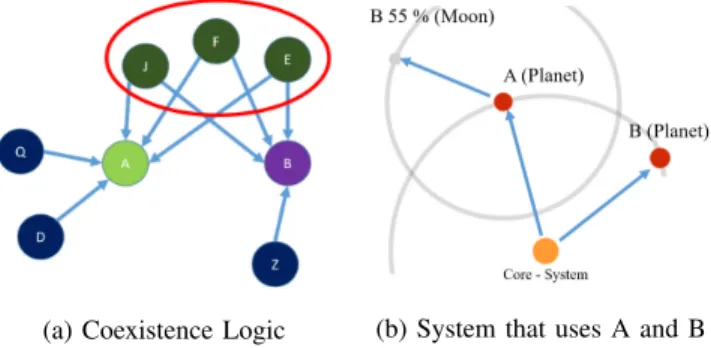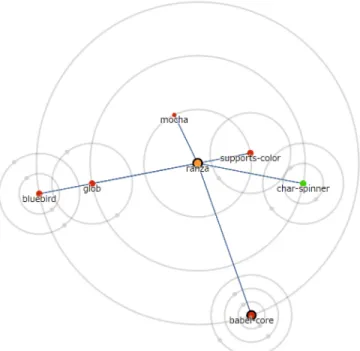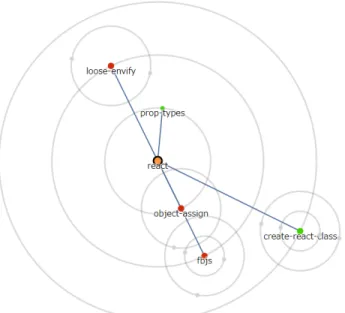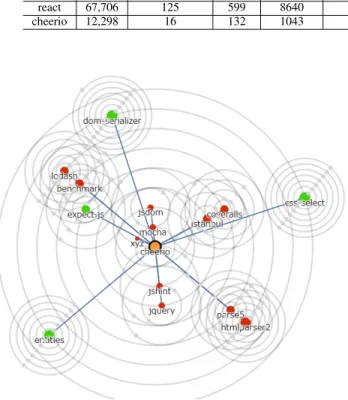SoL Mantra: Visualizing Update Opportunities Based on Library Coexistence
全文
(2) SoL Mantra: Visualizing Update Opportunities Based on Library Coexistence Boris Todorov∗ , Raula Gaikovina Kula† , Takashi Ishio† , Katsuro Inoue∗ ∗ Osaka. University, Osaka, Japan Institute of Science and Technology, Nara, Japan Email: {boris-t, inoue}@ist.osaka-u.ac.jp, {raula-k, ishio}@is.naist.jp † Nara. Abstract—In software development, software reuse has become a pivotal factor in creating and providing high-quality software at a reduced cost. The reuse of a code creates dependencies, which as they increase over time become difficult to manage and avoid compatibility issues or bugs. With newer version releases, come various quality improvements, new features and issue fixes, but deciding whether or not to adopt those is a difficult task for large software with a lot of dependencies. To address those difficulties, we propose SoL Mantra which is a tool that shows update opportunities by leveraging the Wisdom of the Crowd in a software ecosystem. Using this combined knowledge, our tool displays information about the complexity of each update opportunity. The orbital layout provides the means to visualize the update opportunities and demonstrate its merits by showcasing two examples from the JavaScript ecosystem. Through these examples, we demonstrate how maintainers can benefit from SoL Mantra’s visual cues.. devastating problems, such as the heartbleed bug1 . Libraries evolve over time, making additions to their functionalities and addressing various issues that the previous version might have. This evolution is represented by the releases, their corresponding versions and supported documentation.. I. I NTRODUCTION. In this work, we address the problem with updating libraries and propose the peculiar Software Library Mantra tool (SoL Mantra), applying the combined knowledge of all software developers of a language ecosystem (Wisdom of the Crowd) with coexistence coefficient (cc), defined by Kula et al. [9] and described in detail in Section II. We provide information whether or not a system dependency is outdated, by using simple and intuitive visual elements. Furthermore, to illustrate the potential risk from updating a library, we evaluate the popular library usage in the ecosystem and offer suggestions, which libraries should be updated together if either of them is considered for updating. The main technical challenges in achieving results lie in finding a balance between visualization technique and providing enough information without it being unreadable. We demonstrate the usefulness of our tool, by using two visualization examples based on a data sample of popular libraries within the JavaScript ecosystem. The first one consists of a smaller system, while the second one depicts a larger one. In both cases, our tool contributes and provides update opportunity information. With them, we will also display how our tool helps to identify update opportunities and using cc understand the complexities for each candidate. A demonstration with 23 library examples can be observed at https://goo.gl/2Rewn4. For the past decade, predominant practice within software engineering has been the usage of third-party software, also known as software library [1]. The merit of using software libraries lies in the reusing of code. The inherited benefits include reducing the manhours cost when developing new software, safety and stability from codes approved by various developers. However, as time passes, the libraries grow older and newer versions are released, providing security improvements, new features and bug fixes. That also brings risks for software maintainers, whose job is to keep a software running and operational throughout its life cycle. Updating a library dependency could bring all the beforehand mentioned improvements, but can also cause devastating problems to the software. Researchers have observed and document empirically how software developers interact and deal with library updating. Some even conclude based on a large sample of Java clients that use Maven libraries, that high number of systems keep their dependencies outdated [2]. Others provide in-depth analysis on the impact of newer version releases and what changes within them drive developers to adopt newer versions [3], [4]. Software maintainers, have to carefully evaluate various risks while making decisions ”if” and ”when” to update their software’s library dependencies. Studies have been conducted expressing concerns in incompatibility when updating [5], [6]. Oppositely, not updating a library could also lead to. Previous works have tackled the problem of providing a visual aid for update opportunities. Kula et al. [7] visualized the evolution of systems and their dependencies. While this approach uses historical data to determine library update candidates, we apply the combined developer knowledge in the entire ecosystem. Yano et al. [8] proposes VerXCombo, a prototype tool, that presents various library version combinations. Similarly to our work, VerXCombo uses Wisdom of the Crowd to provide library combinations and provides more detailed information.. 1 http://heartbleed.com/.
(3) TABLE I: Ranza Dependencies Library mocha supports-color glob char-spinner bluebird babel-core. (a) Coexistence Logic. Coexistent Library (cc) None mocha(99.09%) mocha(23.05%), supports-color(1.59%) glob(100%), mocha(100%), supports-color(100%) char-spinner(0.2%), glob(49.49%), mocha(12.32%), supports-color(0.85%) bluebird(95.45%), char-spinner(0.76%), glob(95.45%), mocha(45.87%), supports-color(3.17%),. (b) System that uses A and B. Fig. 1: Library Coexistence Mapping. II. T OOL BASIC C ONCEPTS Our main objective is to provide an intuitive visual tool to assist maintainers by providing update opportunities information. The SoL Mantra, checks if a system’s dependencies are up-to-date and by using a coexistence notation to determine the complexity of each potential update. A. Solar System Metaphor Our selected layout for the visualization is the Orbital Layout2 . This visualization was considered after investigating the Hexagonal Binning3 and Dependency Wheel visualization technique4 . This visualization uses the D3.js API5 . B. Basic Data Concepts In order to understand the visualization, we define the following data elements: • System - the program, whose dependencies to other libraries are our concern for visualization. • Library - the programs used by the system or other libraries, forming library dependency directed graph. • Coexistence(cc) - as defined by Kula et al [9], coexistence is a binary relation between two libraries (nodes) in an ecosystem, where those two libraries are used by at least one common library or common system. Fig. 1a is an example of coexistent of libraries. For instance, library A is used by Q, D, J, F and E, respectively, library B by J, F, E and Z. We see that there are three users that use both A and B - J, F and E or we denote: U sersA ∩ U sersB = {J, F, E}, where U sersX denotes the set of users of X. We also define the coexistence coefficient (cc) of A for B as follows: |U sersA ∩ U sersB| (1) |U sersA| meaning, A’s cc for B is the ratio of A’s users which are simultaneously B’s users. For example, libraries babel-core with 6,884 users, and mocha with 3,165 users in npm ecosystem are in coexistence relation, because they share 3,158 common users, thus the cc of babel-core’s for mocha is 0.4587 2 https://github.com/emeeks/d3.layout.orbit 3 https://github.com/d3/d3-hexbin. (45.87%), meaning about half of babel-core’s users are also mocha’s users. On the other hand, mocha’s cc for babel-core is 0.9978, meaning almost all of mocha’s users are also babelcore’s users. C. Visualization Design and Representation Fig. 1b shows our visual design with the system always represents the core of our orbital layout and is denoted by the orange color (sun). All the libraries used by the system are denoted as planets orbiting the system, hence every library will be a separate planet regardless of its coexistence with other libraries. Coexisting libraries will always be orbiting around the library (planet) they coexist with. To further elaborate on the matter, library B is both a planet referenced in the system and a coexistent (moon) with library A. To vividly explain our visualization and its functionalities we will use a real example with a sample package and thoroughly explaining each of the visual elements and how they work. The package in question is ranza6 , a dependency checker package which contains only 6 dependencies, as shown in Table I. Fig. 2 illustrates the SoL Mantra for the ranza system example and the various elements we created: • Core (Sun) - in the center of the visualization, lies the software system that uses libraries. Fig. 2a shows the ranza’s system Sol Mantra, therefore ranza is placed as the core (yellow node). • Planets - the planets are direct representations of the libraries used by the software system. For example on Fig. 2a, there are 6 planets showing the 6 libraries that ranza uses - char-spinner, supports-color, glob, mocha, bluebird and babel-core. The distance from the Sun currently has no meaning, apart from increasing the readability. • Color - every planet has an outdated flag, based on a boolean value. The color filling the planet changes to represent if the system uses the latest version or not, i.e. green - up-to-date and red - outdated. As seen on Fig. 2a char-spinner is green, which denotes it is up-to-date, while supports-color, babel-core, mocha, glob and bluebird are red, therefore update candidates. • Rotation - to make sure outdated packages are easy to spot, we also apply a rotation direction, together with the color as a two-pronged approach to distinguish between up-to-date and outdated libraries. The up-to-date ones,. 4 http://www.redotheweb.com/DependencyWheel/ 5 https://d3js.org/. 6 https://github.com/raphamorim/ranza.
(4) for the outdated flag, we provide a second visualization element that will show potential warnings for update opportunities. The size and speed, based on the number of moons (coexisting libraries), serve the purpose to concretely depict libraries with a high coexisting count. The higher the number, the larger the planet becomes and the slower it rotates on its orbits and the opposite, small planets that orbit faster, means that they have few or no coexisting libraries. For example, a planet with a large number libraries will be larger compared to one without. Oppositely, the speed will be considerably slower. III. A PPLICATION E XAMPLES In this section we will demonstrate the applications of our tool through two distinct examples from the JavaScript npm ecosystem. A. Target Data. (a) Ranza overview, showing all 6 packages in use, 5 flagged as outdated (color and rotation) are candidates for an update.. (b) babel-core’ coexisting libraries. The 5 that orbit around babel-core, show they are coexisting (have a cc with babel-core).. Fig. 2: Ranza Sol Mantra - showing 5 update opportunities based on their color and rotation (not shown) and the correlating update complexity based on their coexistence.. •. •. always orbit in a clockwise direction, while the outdated ones revolve in an opposite fashion. Because we are unable to show the rotation in this paper, the effect can be observed on our tool. Moons - represent coexisting libraries as orbiting the planet they coexist with7 . The moons are duplicates to the libraries that the system uses with the purpose of showing which libraries should be considered to be updated together. As shown in Table I, babel-core has 5 coexisting libraries within the system, which is illustrated onto the Sol Mantra by adding these 5 as the orbiting moons, i.e. Fig. 2b. Size and Speed - similar to the two-pronged approach. To help us evaluate our tool, we selected and applied it to the node package manager (npm)8 . It is the largest JavaScript repository, hosting over 230,000 packages with new ones constantly being added [10]. A package is treated as the system or libraries and it generally uses other libraries in the ecosystem. We selected the top 30 most used and liked packages for 2016. We then gathered various relevant data, such as stars, pull requests, issues, commits. contributors, releases, branches, dependencies, dependents in order to help us assess those projects. In Table II, we provide a general statistics of our generated data and the filtering data. Most of the projects we use have a high star rate on github, with a maximum value of almost 70,000, mean and median with very close values. So we can safely state that these projects are popular within the software community. All of the projects are active and still under development. Proof can be found in the massive numbers of commits, pull requests, issues and releases. The average number of dependencies is at 9, but we were able to run a test on a package with close to 50 dependencies. Some packages did not use any libraries in their software, so we were unable to test them, hence, we were forced to discard 7 from our initial 30, resulting in 23 packages to test. We implemented a script based tool to gather and collect the data needed for the visualization. In detail, to generate our data and calculate cc, we used packages available from the npm repository. In order to check if a library is outdated, we relied upon is-outdated package9 and compared the result with the current version in the package.json file. For the coexistence coefficient, we used several packages in unison. We started by generating the users for every package, with get-dependencies package10 . Secondly, we created the sets using js-combinatorics11 . Finally, by using comparray12 , we 8 https://www.npmjs.com/ 9 https://github.com/rogeriopvl/is-outdated 10 https://github.com/SharonGrossman/get-dependencies 11 https://github.com/dankogai/js-combinatorics. 7 Only. planets can have moons. 12 https://github.com/JonathanPrince/comparray.
(5) TABLE II: Collected Data Summary Data Minimum Maximum Mean Median. Stars 917 67,706 9914 11,863. Pull Requests 0 180 30 21. Issues 0 690 149 168. Commits 186 8640 1492 2162. Contributors 15 1595 158 177. Releases 11 396 77 89. Branches 1 103 17 14. Dependencies 0 47 9 7. Dependents 1 24,432 4272 2279. Tested Packages: express, request, browserify, grunt, pm2, socket.io, mocha, gulp-uglify, cheerio, passport, hapi, react, karma, pug, mysql, less, mongodb node.js driver, jshint, morgan, webpack, restify, magick, jsdom. extracted the common packages between all users of each set and calculated the final cc score. To illustrate the use of our visualization and how a developer would use our tool, we selected two packages from our final 23. The first one is react13 , and is the highest starred package from our test data, with 67,706 stars on GitHub. For the second example, we chose cheerio14 in order to showcase how our tool performs on a larger system. Both examples’ data can be seen in Table III. B. Example - react React is a popular library used for interface creation. After generating the data, we can see the results, plotted onto our orbital layout. Fig. 3a Shows react system overview with a total of 5 dependencies, represented by the 5 planets orbiting the core. Continuing, 2 of them are green colored, i.e. up-todate, and 3 are red, i.e. outdated. From the overview, we can see that loose-envify, objectassign and fbjs are outdated and present an update opportunity. To evaluate the potential risks, their coexisting libraries have to be examined. By hovering over with the mouse and inspecting loose-envify, we can see that it has 100% cc with prop-types and object-assign (Fig. 3b). fbjs has 3 coexisting packages in this example and as seen on Fig. 3c - 95.7% cc with prop-types and object-assign, and 23.16% with loose-envify. For react or tool results conclude that there are total of 3 update opportunities based on outdated flags. By inspecting them, the software developer can evaluate the update complexity with the reported cc values. Loose-envify has 100% cc with both of its moons, therefore careful evaluation should be made before updating. The case is similar for fbjs, since it has 95.7% with 2 of the moons. Although the cc with loose-envify is only 23.16%, it should still be evaluated.. (a) React, SoL Mantra overview with its 5 dependencies: 2 upto-date and 3 update opportunities. (b) loose-envify update opportunity complexity. C. Example - cheerio For the second example, we selected cheerio library package, providing implementation of core jQuery15 , designed specifically for servers. Cheerio compared to the previous example, references more library packages in its code, and we will use that to show how our tool handles a larger system. Fig. 4, shows cheerio’s SoL Mantra with 15 libraries that have high coexistence between each other. 13 https://github.com/facebook/react 14 https://github.com/cheeriojs/cheerio 15 https://jquery.com/. (c) fbjs update opportunity complexity. Fig. 3: React SoL Mantra with 3 complex update opportunities. After assessing the up-to-date libraries, we direct our attention towards the outdated ones. There are 11 update opportunities in total and 6 of them have high coexistence count - istanbul, coveralls, parse5, htmlparser2, benchmark and lodash. The full cc information can be observed on our.
(6) TABLE III: Examples Data Data react cheerio. Stars 67,706 12,298. Pull Requests 125 16. Issues 599 132. Commits 8640 1043. Contributors 1011 88. Releases 61 52. Branches 38 14. Dependencies 4 18. Dependents 12,479 5358. Because we only evaluate the data provided by the npm repository, we do not consider if the library references within the code are being used. Our tool only lists those that are registered and written on the package.json file of the respective project. Improvements to SoL Mantra could be necessary based on use cases feedback. First and foremost, for larger software systems that use library packages with long names, the ones placed near the core, will become unreadable, unless focused specifically. Second, if all libraries have data similarity, they could overlap in neighboring orbits, which reduces visibility.. Fig. 4: Cheerio SoL Mantra - 11 outdated and 4 up-to-date libraries.. tool’s result page. Lastly in this example, we observe an interesting case, where xyz package does not have any coexistence on its own, but coexists with the others, apart from dom-serializer, with varying coexistence - from 0.05% with lodash, to 48% with dom-serializer. From the cheerio overview visualization, we see that it uses packages which have high coexistence amongst each other. All the 11 outdated flags should carefully be inspected to evaluate the update complexity of each individually. In conclusion, in both examples, our tool flagged the outdated libraries. Even in a bigger system like cheerio all 11 outdated libraries are easily detectable. Through cc we evaluate the complexity of each update opportunity. In smaller systems like react, the libraries didn’t have high coexistence count but have high cc values, thus an easy update decision could be made. For the bigger system case where most packages have a high coexistent count, each update opportunity is more intricate and must be carefully evaluated. IV. T HREATS TO VALIDITY AND L IMITATIONS Our collected data is based on established projects that have been developed by dedicated teams, hence, we have not tested smaller or personal projects. The projects we tested, could have specific library version for internal reasons. Further evaluating with use cases by real-life developers is required.. V. C ONCLUSION AND F UTURE W ORK In this paper, we propose our Sol Mantra tool, providing information for library update opportunities to software maintainers, by applying the coexistence coefficient. Future work includes evaluating the usefulness, effectiveness and scalability of the SoL Mantra, by creating test cases, and including feedback from software maintainers. Depending on the results, further adjustments and enhancements will be added. Another potential visual element to explore for the future is the distance from the core. Currently, it serves only an aesthetic function to increase visibility, i.e. planets with higher moon count are pushed further out. ACKNOWLEDGMENTS This work is supported by JSPS KANENHI (Grant Numbers JP25220003). R EFERENCES [1] C. Ebert, ”Open source software in industry” in IEEE Software, Vol. 25, No.03, pp. 52-53, 2008. [2] R. G. Kula, D. M. German, A. Ouni, T. Ishio and K. Inoue, ”Do developers update their library dependencies?”, Emp. Soft. Eng., 2017. [3] G. Bavota, G. Canfora, M. Di Penta, R. Oliveto and S. Panichella, ”How the Apache community upgrades dependencies: an evolutionary study”, Emp. Soft. Eng., Vol. 20, No. 5, pp. 1275-1317, 2015. [4] C. Bogart, C. K¨astner and J. Herbsleb, ”When it breaks, it breaks: how ecosystem developers reason about the stability of dependencies”, ASE (Workshop SCGSE), pp. 86-89, Lincoln, NE, 2015. [5] S. Raemaekers, A. van Deursen, and J. Visser, ”Semantic Versioning versus Breaking Changes: A Study of the Maven Repository”, 14th IEEE SCAM, pp. 215-224, 2014. [6] R. G. Kula, D. M. German, T. Ishio, and K. Inoue, ”Trusting a Library: A Study of the Latency to Adopt the Latest Maven Release”, 22nd IEEE SANER, Vol. 22, pp. 520-524, Montreal, Canada, 2015. [7] R. G. Kula, C. De Roover, D. M. German, T. Ishio and K. Inoue (2014), ”Visualizing the Evolution of Systems and Their Library Dependencies” in 2nd IEEE VISSOFT, pp. 127-136, Victoria, BC, Canada, 2014. [8] Y. Yano, R. G. Kula, T. Ishio and K. Inoue (2015), ”VerXCombo: An interactive data visualization of popular library version combinations” in 23rd IEEE ICPC, pp. 291-294, Florence, Italy, 2015. [9] R. G. Kula, C. De Roover, D. M. German, T. Ishio and K. Inoue, ”Modeling Library Popularity within a Software Ecosystem”, Tech. Rep. Osaka University, Software Engineering Laboratory. [10] E. Wittern, P. Suter, S. Rajagopalan, ”A Look at the Dynamics of the JavaScript Package Ecosystem”, 13th MSR, pp. 351-361, Austin, TX, USA, 2016..
(7)
図




関連したドキュメント
2 Combining the lemma 5.4 with the main theorem of [SW1], we immediately obtain the following corollary.. Corollary 5.5 Let l > 3 be
Finally, in Section 7 we illustrate numerically how the results of the fractional integration significantly depends on the definition we choose, and moreover we illustrate the
This paper is devoted to the investigation of the global asymptotic stability properties of switched systems subject to internal constant point delays, while the matrices defining
The aim of this work is to prove the uniform boundedness and the existence of global solutions for Gierer-Meinhardt model of three substance described by reaction-diffusion
In this paper, we focus on the existence and some properties of disease-free and endemic equilibrium points of a SVEIRS model subject to an eventual constant regular vaccination
Maria Cecilia Zanardi, São Paulo State University (UNESP), Guaratinguetá, 12516-410 São Paulo,
Classical definitions of locally complete intersection (l.c.i.) homomor- phisms of commutative rings are limited to maps that are essentially of finite type, or flat.. The
Yin, “Global existence and blow-up phenomena for an integrable two-component Camassa-Holm shallow water system,” Journal of Differential Equations, vol.. Yin, “Global weak